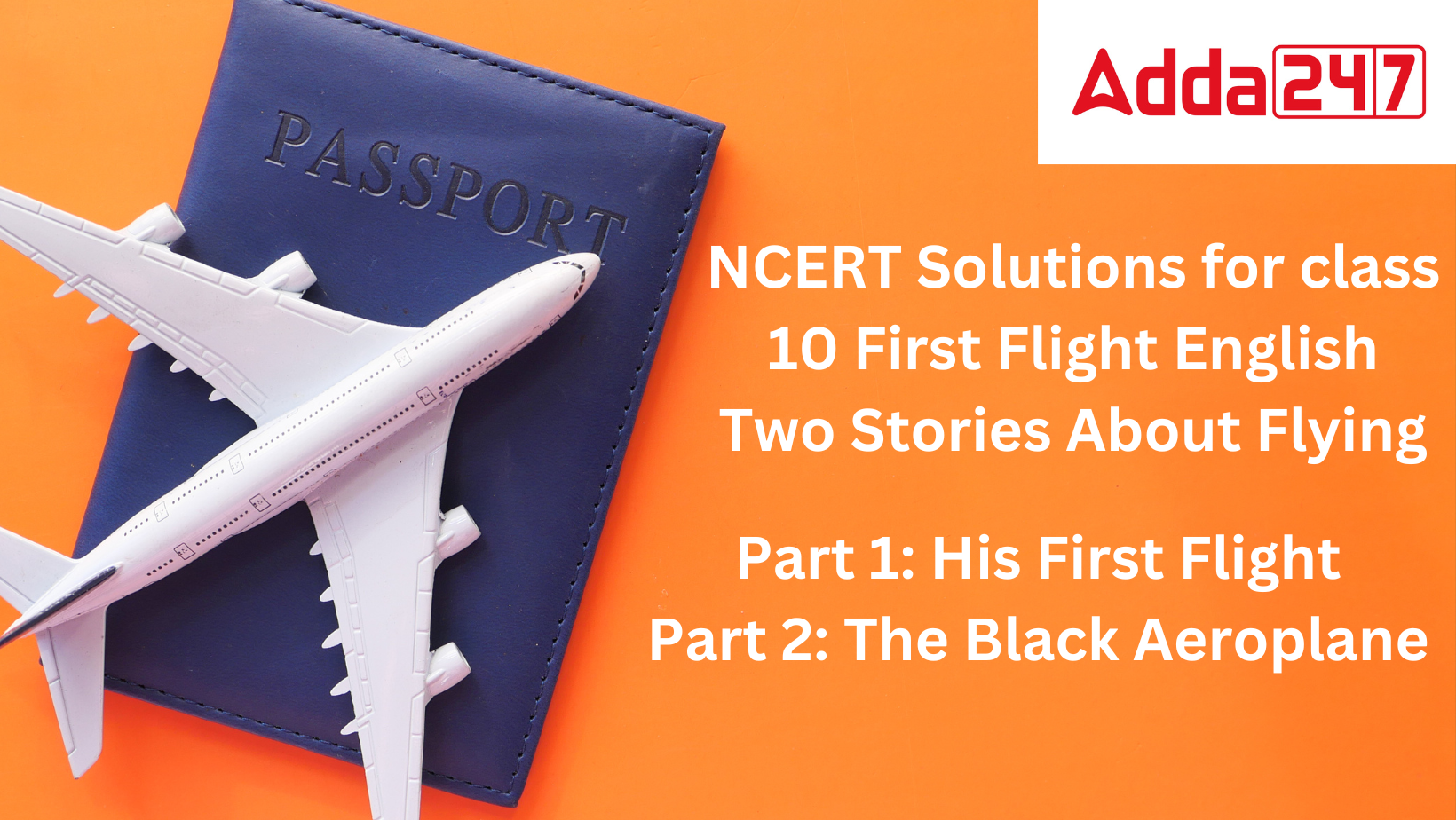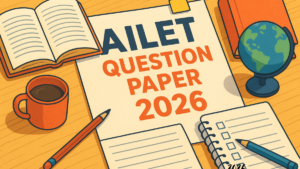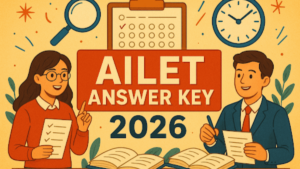Ever wondered how it feels to take your first flight in the sky? Class 10 English First Flight Chapter 3: Two Stories About Flying gives you that thrilling experience through two exciting tales. The first part, His First Flight by Liam O’Flaherty, shows how a young seagull overcomes fear and learns to fly. The second, Black Aeroplane by Frederick Forsyth, is a mysterious story of a pilot caught in a storm and rescued in an unexpected way. Here, you’ll find complete NCERT Solutions for this chapter written in simple language. Students can also download the free PDF for easy revision anytime.
NCERT Solutions For Class 10 English First Flight Chapter 3 Two Stories About Flying
NCERT Solutions for Class 10 English First Flight Chapter 3: Two Stories About Flying are a great way for students to gain a deeper understanding of the chapter. They guide students in writing accurate answers, which improves their comprehension and presentation skills. Students can clear their doubts and prepare confidently by using these NCERT Solutions, which are also very helpful for quick revision before tests. NCERT Solutions are important because they save time, strengthen concepts, and help students score better marks.
Two Stories about Flying Part 1: His First Flight Summary
Liam O’Flaherty’s short story “His First Flight” is about a juvenile seagull who was hesitant to fly for the first time because he was concerned that his wings wouldn’t be able to hold him. Despite having shorter wings than him, all of his siblings bravely ventured out into the open air. On the other hand, the juvenile bird’s suspicion kept him from summoning the bravery to jump.
When he attempted to fly, he would flinch and retreat whenever he moved closer to the edge of the cliff. The continuous disciplining and threats from his parents that he would starve to death on the ledge if he didn’t fly away were ineffective. He would merely see his parents instructing his siblings in wave skiing and fish diving. The entire family went to a large plateau one wonderful day to mock the young seagull for his timidity. He could feel the heat and was already hungry from the previous night’s darkness as the sun’s rays blazed on his ledge. The baby bird pleaded with his mother to bring him food.
When his mother swiftly grabbed a piece of fish and flew up to him, he let out a happy scream. He immediately leaned out and jumped at the fish, his desire driving him insane. He felt himself plummeting downward as he suddenly fell outward in the wide area, and a frightful panic grabbed him. The next instant, he felt his wings begin to extend, and he was able to fly without fear. Finally, the young seagull took his first flight and soared higher and skimmed through the waves, and dived along with his siblings.
Two Stories about Flying Part 2: The Black Aeroplane Summary
A pilot is the main character in Fredrik Forsyth’s suspenseful tale “Black Aeroplane.” The story’s narrator is a pilot who yearned to see his family in England and have a hearty breakfast with them. In order to visit his family, he had to take a flight from France to England. After passing through Paris, he saw storm clouds that resembled black mountains. However, when he sailed into the clouds, he noticed that everything had turned utterly black all around him. He lost control of the aircraft and could see nothing outside of it.
He suddenly became aware of a nearby airplane with no lights on its wings. The pilot of that aircraft motioned for him to follow by waving his hands. Due to the inability to receive his plane’s radio signals and the fact that the fuel tank was low, he blindly followed the other pilot. With the assistance of the other pilot, he soon made it through the gloomy clouds and made a safe runway landing. He wanted to express his gratitude to the other pilot for saving his life, so after landing, he asked the receptionist who the other pilot was. But the woman in the control room assured him that his aircraft was the only one in the nighttime sky.
NCERT Solutions For Class 10 English First Flight Chapter 3 Two Stories About Flying: PDF
To make your learning easier, we have provided a free PDF of NCERT Solutions for Class 10 English First Flight Chapter 3: Two Stories About Flying. This PDF is designed to help students study anytime, anywhere, without any hassle. With well-explained answers in simple language, it is perfect for quick understanding and revision. Students can use it to prepare effectively for exams, clear doubts, and practice important questions. The best part is that you can easily download the PDF and keep it for future reference, so your study material is always just one click away.
NCERT Solutions For Class 10 English First Flight Chapter 3 Two Stories About Flying: Solved Textbook Questions
NCERT Solutions for Class 10 English First Flight Chapter 3 Two Stories About Flying are provided here in an easy and clear manner. This chapter includes two inspiring stories that highlight courage, fear, and determination. With the help of these well-structured solutions, students can understand the meaning of the text better and prepare confidently for their exams. Each answer is explained in simple language so that students can grasp the ideas quickly. Students can check the solved question answers below.
Two Stories about Flying Part 1: His First Flight
Thinking about the Text (Page 36)
Question 1: Why was the young seagull afraid to fly? Do you think all young birds are afraid to make their first flight or are some birds timider than others? Do you think a human baby also finds it a challenge to take its first steps?
Answer: It was the juvenile seagull’s first flight, and he was anxious to fly for fear of falling and getting wounded. He worried that his wings wouldn’t be able to support him on his first flight.
Yes, I think it’s pretty normal and evident that trying something new can be intimidating and a little difficult. Obviously, taking their first flight must be terrifying for all birds.
Similar to a baby animal, a human baby experiences fear and finds it extremely difficult to take its first steps, learn to crawl or walk on its own without assistance.
Question 2: “The sight of the food maddened him.” What does this suggest? What compelled the young seagull to finally fly?
Answer: The juvenile bird was unable to summon the courage necessary for his initial flight. His family nagged him to jump all the time, but he never did. Until he was ready to jump, they allowed him to stand on the brink. He had been left there for more than 24 hours and was already starving. He was ultimately forced to fly by this hunger. The sight of his mother chewing into a chunk of fish that was laying at her feet just made his hunger worse. He sobbed bitterly, pleading with her to get him some food. Upon observing this, the young seagull cried in delight and anticipation as his mother flew towards him carrying food in her beak. However, she stopped midway and the young seagull wondered why she did not come closer to him. Maddened by hunger, he dived at the food in his mother’s beak. At that moment, he fell outwards and downwards into the great expanse of sea beneath the cliff. He was terrified and could feel his heart stood still. But soon enough, he felt his wings spread outwards and he realized that he could fly like others. Therefore, his hunger overpowered his fear and finally he made his first flight joyfully.
Question 3: “They were beckoning to him, calling shrilly.” Why did the seagull’s father and mother threaten him and cajole him to fly?
Answer: The parents of the young seagull kept calling him and did everything they could to get him to take his first flight. He was terrified of plunging from the cliff, therefore he was quite hesitant to take the leap. He watched as his sister and brothers took off in flight, but he was afraid to exert any effort. Because of this, his entire family had abandoned him on his ledge and had tried to get him to fly by threatening and bribing him.
Question 4: Have you ever had a similar experience, where your parents encouraged you to do something that you were too scared to try? Discuss this in pairs or groups.
Answer: Yes, when I was in the fourth grade and trying to learn how to ride a bike, I had a similar experience. I struggled at first to maintain my balance and frequently fell, which made me afraid of cycling. I gave up riding because I couldn’t get over my phobia, but my parents would constantly nag me to give it a shot anytime I had the chance. My father used to hold the bicycle behind me while I tried to balance myself, but everytime he left, I would topple over. My cycling abilities gradually improved as I practised every day, and eventually I was able to ride without my father’s assistance from behind. This greatly increased my confidence.
(Note: Students can write this answer as per their personal experience.)
Question 5: In the case of a bird flying, it seems a natural act, and a foregone conclusion that it should succeed. In the examples you have given in answer to the previous question, was your success guaranteed, or was it important for you to try, regardless of a possibility of failure?
Answer: When attempting to acquire or take up a new skill, it is normal for everyone to experience some early difficulties. We often hesitate to carry out a specific duty or try something new out of fear of failing. The seagull’s parents repeatedly bribed him to go to the air. Similar to this, my father constantly encouraged me to start cycling while I was learning to ride a bike for the first time. At that time, it was crucial for me to get over my phobia and learn to cycle for my own benefit.
Yes, my success was promised since success is a given for everyone who is focused and determined to succeed. In addition, we are all familiar with the saying, “Practice makes a man perfect.”
Two Stories about Flying Part 2: Black Aeroplane
Thinking about the Text (Page 40)
Question 1: “I’ll take the risk.” What is the risk? Why does the narrator take it?
Answer: The Dakota DS 088’s pilot was anxious to go back to England so he could spend the holiday with his family. His aircraft was caught in a massive storm of dark clouds as it travelled. He made the decision to fly directly into the storm in order to meet his family for a hearty English breakfast since he did not want to lose the occasion. He thus decided to take the chance of flying through the storm despite the low visibility.
Question 2: Describe the narrator’s experience as he flew the aeroplane into the storm.
Answer: The author’s aircraft began to hop and spin in the air as it reached the large cloud storm. The jet was surrounded by absolutely black storm clouds, and he was unable to see anything outside. He noticed that the compass and other devices had ceased working because of the erratic weather. The pilot had a terrifying and harrowing encounter. He could only fly for ten minutes in his plane because the gasoline tank was almost empty. Another black aeroplane with no lights on its wings emerged beside him out of nowhere, and its pilot motioned for him to follow.
Question 3: Why does the narrator say, “I landed and was not sorry to walk away from the old Dakota…”?
Answer: After being caught in a dense storm of gloomy clouds, the pilot was relieved to arrive safely and was not sorry to leave the old Dakota. He wanted to thank the pilot of the other black aeroplane for saving his life in such a terrifying scenario and was overcome with gratitude for him. He was regretting the fact that he was unable to express his gratitude to the person who made it possible for him to safely land on the runway.
Question 4: What made the woman in the control centre look at the narrator strangely?
Answer: When the narrator mentioned the black aircraft that assisted him in safely landing on the runway, the woman in the control centre gave him a strange look. She gave him a startled expression and informed him that nobody else was in the sky during the storm besides the narrator’s plane. The narrator’s plane was the only one in the night sky, according to the radar.
Question 5: Who do you think helped the narrator to reach safely? Discuss this among yourselves and give reasons for your answer.
Answer: Who the unidentified pilot was who assisted the storyteller cannot be said with certainty. As there was just the narrator’s Dakota DS 088 visible on the radar, it is safe to presume that it was the narrator who conquered his fear in the storm. The pilot may have dreamed that someone saved him in that terrifying scenario. However, he was a skilled pilot in his own right because he dared to fly through a violent storm and safely land on the runway.












 AILET Question Paper 2026 with Solution,...
AILET Question Paper 2026 with Solution,...
 AILET Answer Key 2026 , Download Provisi...
AILET Answer Key 2026 , Download Provisi...
 UP NEET Counselling 2025 Round 5 Merit L...
UP NEET Counselling 2025 Round 5 Merit L...














